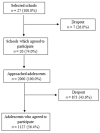A Cross-Sectional Study of Oral Health Status and Behavioral Risk Indicators among Non-Smoking and Currently Smoking Lithuanian Adolescents
- PMID: 37623192
- PMCID: PMC10454649
- DOI: 10.3390/ijerph20166609
A Cross-Sectional Study of Oral Health Status and Behavioral Risk Indicators among Non-Smoking and Currently Smoking Lithuanian Adolescents
Abstract
The purpose of this study was to evaluate oral health status, behavioral risk indicators, and the impact of smoking on oral health among Lithuanian adolescents. This representative cross-sectional study was conducted among 15-year-old Lithuanian adolescents. The method of multistage cluster sampling was used. A total of 1127 adolescents met the inclusion criteria. Two originally created self-reported questionnaires were used in this study. Dental caries, periodontal status, and oral hygiene status were evaluated by four trained researchers. A p-value ≤ 0.05 was set to indicate statistically significant differences. Statistical analysis included Mann-Whitney, Kruskal-Wallis, and Spearman correlation tests. Out of all the participants, 9.6% self-reported being a current tobacco smoker. The mean PI value was 1.14 ± 0.69 among all the participants. Currently smoking adolescents had more active caries lesions (D-S) than those who did not smoke (13.2 ± 16.4 vs. 9.8 ± 10.7, p = 0.023). Considering periodontal status, non-smoking adolescents had significantly lower mean PSR index scores than current smokers (0.52 ± 0.51 vs. 0.61 ± 0.50, p = 0.0298). Tobacco smoking and the consumption of energy drinks were significantly associated (OR = 3.74, 95% CI 2.66-5.26, p < 0.001) among participants. Currently smoking adolescents tended to have improper dietary habits, especially a higher consumption of energy drinks; thus, they were more likely to have active dental caries lesions, as well as poorer periodontal status, than their non-smoking peers.
Keywords: adolescent; dental caries; oral health; periodontal status; smoking.
Conflict of interest statement
The authors declare no conflict of interest.
Figures
References
-
- Chapple I.L., Bouchard P., Cagetti M.G., Campus G., Carra M.C., Cocco F., Nibali L., Hujoel P., Laine M.L., Lingstrom P., et al. Interaction of lifestyle, behavior or systemic diseases with dental caries and periodontal diseases: Consensus report of group 2 of the joint EFP/ORCA workshop on the boundaries between caries and periodontal diseases. J. Clin. Periodontol. 2017;44:S39–S51. doi: 10.1111/jcpe.12685. - DOI - PubMed
-
- Giacaman R.A., Fernández C.E., Muñoz-Sandoval C., León S., García-Manríquez N., Echeverría C., Valdés S., Castro R.J., Gambetta-Tessini K. Understanding dental caries as a non-communicable and behavioral disease: Management implications. Front. Oral Health. 2022;3:764479. doi: 10.3389/froh.2022.764479. - DOI - PMC - PubMed
-
- American Academy of Pediatric Dentistry . The Reference Manual of Pediatric Dentistry. American Academy of Pediatric Dentistry; Chicago, IL, USA: 2022. Adolescent Oral Health Care; pp. 282–291.
MeSH terms
LinkOut - more resources
Full Text Sources
Medical
Research Materials
Miscellaneous


